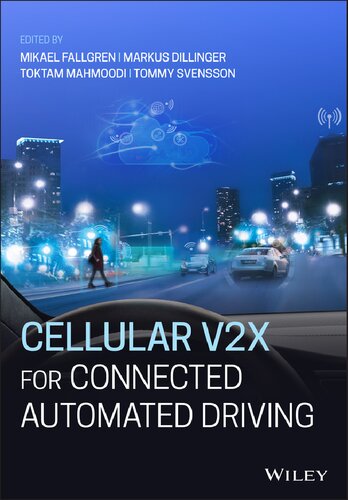

Most ebook files are in PDF format, so you can easily read them using various software such as Foxit Reader or directly on the Google Chrome browser.
Some ebook files are released by publishers in other formats such as .awz, .mobi, .epub, .fb2, etc. You may need to install specific software to read these formats on mobile/PC, such as Calibre.
Please read the tutorial at this link: https://ebookbell.com/faq
We offer FREE conversion to the popular formats you request; however, this may take some time. Therefore, right after payment, please email us, and we will try to provide the service as quickly as possible.
For some exceptional file formats or broken links (if any), please refrain from opening any disputes. Instead, email us first, and we will try to assist within a maximum of 6 hours.
EbookBell Team

0.0
0 reviewsA unique examination of cellular communication technologies for connected automated driving, combining expert insights from telecom and automotive industries as well as technical and scientific knowledge from industry and academia
Cellular vehicle-to-everything (C-V2X) technologies enable vehicles to communicate both with the network, with each other, and with other road users using reliable, responsive, secure, and high-capacity communication links. Cellular V2X for Connected Automated Driving provides an up-to-date view of the role of C-V2X technologies in connected automated driving (CAD) and connected road user (CRU) services, such as advanced driving support, improved road safety, infotainment, over-the-air software updates, remote driving, and traffic efficiency services enabling the future large-scale transition to self-driving vehicles. This timely book discusses where C-V2X technology is situated within the increasingly interconnected ecosystems of the mobile communications and automotive industries.
An expert contributor team from both industry and academia explore potential applications, business models, standardization, spectrum and channel modelling, network enhancements, security and privacy, and more. Broadly divided into two parts―introductory and advanced material―the text first introduces C-V2X technology and introduces a variety of use cases and opportunities, requiring no prerequisite technical knowledge. The second part of the book assumes a basic understanding of the field of telecommunications, presenting technical descriptions of the radio, system aspects, and network design for the previously discussed applications. This up-to-date resource:
Thanks to its mix of introductory content and technical information, Cellular V2X for Connected Automated Driving is a must-have for industry and academic researchers, telecom and automotive industry practitioners, leaders, policymakers, and regulators, and university-level instructors and students.